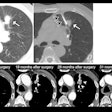Occupational doses to radiologic technologists imparted by assistance with fluoroscopically-guided interventional procedures are generally low, but they do need careful monitoring, a team of National Institute of Health (NIH) researchers has found.
Investigators led by Cato Milder, PhD, of Rockville, MD-based NCI reported that median annual dose corresponding to performing fluoroscopically-guided interventional procedures was 0.65 mSv, with higher doses associated with close proximity to patients (that is, less than three feet, for a median annual dose of 1.20 mSv) and performing more than 20 of the procedures per month (median 0.75 mSv). (The U.S. Nuclear Regulatory Commission limits occupational radiation exposure to 50 mSv per year.) The group's findings were published April 8 in the Journal of Vascular and Interventional Radiology.
"[The study supports] the need to update and revise current estimates of cumulative organ-absorbed doses [among radiologic technologists] for more precise assessment of occupational radiation exposure and disease risks," Milder and colleagues noted.
Use of fluoroscopically-guided interventional procedures increased rapidly between the 1980s and the 2000s, in part due to technology advances that "expanded use of interventional radiology in cardiology, orthopedics, oncology, and other specialties," the group explained. And although these procedures benefit patients by reducing recovery time compared with conventional surgery, they expose medical staff to significant radiation.
Milder and colleagues assessed radiation dose to technologists assisting with fluoroscopically-guided interventional procedures using information taken from 43,823 participants in the U.S. Radiologic Technologists (USRT) cohort who responded to work history questionnaires that were administered between 2012 and 2014. The data consisted of summaries of 762,310 annual personal radiation dose equivalents between 1980 and 2020, and they included 19,651 technologists who helped perform fluoroscopically-guided interventional procedures at least once a month for 12 consecutive months at any time during the study period.
The investigators found that, although occupational doses associated with assisting with fluoroscopically-guided interventional procedures was generally low, they did vary with exposure frequency, procedure type, and proximity to patients.
"[Our] results underscore the importance of vigilant radiation exposure monitoring and adequate protective equipment and safety training for modern-day medical radiation workers," Milder and colleagues concluded.
The complete study can be found here.



















